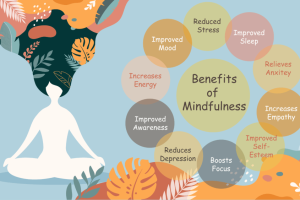Unlock the Power of Mindfulness: A Pathway to Wellness and Vitality

Introduction to Mindfulness
Understanding the Concept of Mindfulness
Mindfulness is more than just a buzzword; it’s a practice rooted in ancient traditions that has gained newfound popularity in our fast-paced modern world. Essentially, mindfulness involves paying deliberate attention to the present moment without judgment. This can be achieved through techniques such as meditation, breathing exercises, or simply observing one’s thoughts and feelings as they arise. Consider a busy day at work where you find yourself overwhelmed with tasks. Instead of succumbing to stress, you take a moment to pause, breathe, and focus on the present. This act of being fully engaged with the current moment, rather than worrying about the past or future, is the essence of mindfulness.
- Unlock the Power of Mindfulness: A Pathway to Wellness and Vitality
- Introduction to Mindfulness
- Understanding the Concept of Mindfulness
- Benefits of Practicing Mindfulness
- The Science Behind Mindfulness
- Effect of Mindfulness on the Brain
- Impact of Mindfulness on Physical Health
- Techniques for Practicing Mindfulness
- Breathing Exercises
- Mindful Meditation Practices
- Mindfulness for Emotional Well-being
- Managing Stress and Anxiety
- Enhancing Self-awareness through Mindfulness
- Mindfulness for Improving Relationships
- Cultivating Compassion and Empathy
- Communicating Mindfully in Relationships
Benefits of Practicing Mindfulness
The benefits of practicing mindfulness are both profound and wide-ranging. Engaging in mindfulness can transform one’s mental and emotional landscape, leading to an overall improved quality of life. Here are some of the most notable benefits:
- Stress Reduction: Regular mindfulness practice helps lower cortisol levels, the hormone responsible for stress.
- Enhanced Concentration: Mindfulness fosters better focus and attention, making it easier to tackle tasks efficiently.
- Emotional Regulation: By observing thoughts without judgment, individuals can learn to respond to their emotions more effectively rather than react impulsively.
- Increased Self-awareness: Mindfulness encourages introspection, allowing people to gain insight into their thoughts, habits, and behaviors.
Many individuals who have integrated mindfulness into their daily routines report feeling more grounded and centered. For example, a teacher might take a few moments before classes to engage in mindful breathing, resulting in a more calm and focused atmosphere in the classroom. By understanding the concept of mindfulness and recognizing its benefits, individuals can embark on a journey toward greater emotional well-being and resilience. This foundation paves the way for exploring how mindfulness impacts the mind and body, enriching the overall life experience.
The Science Behind Mindfulness
Effect of Mindfulness on the Brain
The exploration of mindfulness delves into known scientific domains, particularly its remarkable effects on the brain. Recent neuroimaging studies have shown that regular mindfulness practice can lead to structural and functional changes in the brain. Areas of the brain associated with emotion regulation, decision-making, and self-awareness exhibit enhanced activity. For example, the prefrontal cortex—a region responsible for higher-order thinking—shows increased gray matter density in individuals who practice mindfulness regularly. Moreover, the amygdala, which plays a significant role in our stress response, tends to shrink in size with consistent mindfulness practice. This shift can lead to a reduction in anxiety and an improved capacity for emotional regulation.
- Key Changes in the Brain:
- Greater activation of the prefrontal cortex: Enhances decision-making and impulse control.
- Reduced size of the amygdala: Leads to decreased fear and anxiety responses.
- Improved connectivity within brain networks: Fosters better cognitive flexibility and emotional resilience.
These brain changes showcase the dynamic impact that mindfulness can have, reinforcing the notion that our mental habits can physically alter our brain structure.
Impact of Mindfulness on Physical Health
The benefits of mindfulness extend beyond mental well-being, significantly impacting physical health as well. Research indicates that mindfulness practices can lead to various physiological improvements, promoting overall wellness.
- Notable Physical Health Benefits:
- Lower Blood Pressure: Mindfulness is associated with reductions in blood pressure, which can decrease the risk of heart disease.
- Improved Sleep Quality: Many mindfulness practitioners report better sleep and fewer insomnia symptoms due to reduced stress and anxiety.
- Enhanced Immune Response: Studies have shown that practicing mindfulness may bolster the immune system, enabling the body to fight off infections more effectively.
An inspiring example can be found in hospitals where mindfulness programs have been integrated into treatments for chronic illness. Patients participating in mindfulness training often report reduced pain, heightened mood, and improved overall health outcomes. Both the brain and the body respond positively to mindfulness, presenting a compelling case for incorporating this practice into daily life. With a clearer understanding of the science behind mindfulness, individuals can see how this age-old practice remains relevant and beneficial in today’s world.
Techniques for Practicing Mindfulness
Breathing Exercises
One of the most accessible techniques for practicing mindfulness is through breathing exercises. Focusing on the breath connects individuals to the present moment and helps calm the mind, making it an invaluable practice for anyone new to mindfulness or looking to enhance their routine. Imagine sitting in a bustling café. There are conversations all around, but you choose to focus solely on your breath. This simple act can create a sense of peace amidst chaos. Here are some effective breathing exercises to try:
- Diaphragmatic Breathing(also known as belly breathing):
- Sit or lie comfortably, placing one hand on your chest and the other on your belly.
- Inhale deeply through your nose, letting your belly rise while keeping your chest still.
- Exhale slowly through your mouth, feeling your belly fall. Repeat for several minutes.
- 4-7-8 Breathing Technique:
- Inhale through your nose for a count of 4.
- Hold your breath for a count of 7.
- Exhale through your mouth for a count of 8.
- Repeat this cycle four times.
Integrating these breathing exercises into daily life can bolster mindfulness and lead to a greater sense of calm.
Mindful Meditation Practices
Another powerful technique for practicing mindfulness is through meditation. Mindful meditation allows individuals to observe their thoughts and sensations without judgment, fostering deeper self-awareness and presence. Here are some popular meditation practices to explore:
- Body Scan Meditation:
- Lay down in a quiet space and close your eyes.
- Bring your attention to your feet, noticing any sensations, tension, or relaxation.
- Gradually move your focus up your body, from your legs to your belly, chest, and head, taking note of each area.
- Loving-Kindness Meditation(Metta):
- Start by sitting comfortably and focusing on your breath.
- Silently repeat phrases such as, “May I be happy, may I be healthy, may I be safe, may I live with ease.”
- After a few minutes, extend your wishes to loved ones, acquaintances, and even those with whom you have difficulties.
Incorporating daily meditation practices, even for just a few minutes, can yield significant mental and emotional benefits. Creating a dedicated space and time for these practices can make them a cherished part of your routine. As individuals explore these techniques, they will find that mindfulness can enhance their day-to-day experiences, leading to greater awareness and tranquility in all aspects of life.
Mindfulness for Emotional Well-being
Managing Stress and Anxiety
Mindfulness serves as a powerful tool for managing stress and anxiety, offering individuals effective strategies to navigate life’s challenges with resilience. In our frenetic world, stress is often a constant companion. However, cultivating mindfulness can provide avenues for relief and calm. When faced with a stressful situation—like preparing for a big presentation—one might feel a whirlwind of thoughts and emotions. Practicing mindfulness allows for the recognition of these feelings without becoming overwhelmed. Here are some effective strategies:
- Mindful Observation: Take a moment to pause and notice your surroundings. For instance, if you’re indoors, you might focus on the feeling of your feet on the ground or the texture of a chair. Engaging deeply with the present can shift your mind away from anxious thoughts.
- Journaling: Writing down thoughts and feelings can help externalize anxiety. Setting aside five to ten minutes daily for mindful journaling allows you to express worries without judgment, freeing the mind for clarity.
- Progressive Muscle Relaxation: This technique involves tensing and then relaxing each muscle group in the body, starting from the toes and moving up to the head. It promotes relaxation and helps in releasing built-up tension.
By incorporating these strategies into daily practice, individuals can significantly reduce their stress and anxiety levels, creating a more balanced emotional landscape.
Enhancing Self-awareness through Mindfulness
Beyond managing stress, mindfulness also plays a critical role in enhancing self-awareness. By focusing on the present moment and observing thoughts and feelings, individuals can gain profound insights into their behaviors and motivations. Consider a moment of frustration—perhaps a disagreement with a loved one. A mindful approach invites reflection on not just what is happening, but why it triggers such emotions. Here’s how mindfulness can enhance self-awareness:
- Mindful Reflection: Set aside time to think about your reactions and feelings. Ask yourself questions such as, “What triggered my response? What emotions am I experiencing right now?” This process fosters a deeper understanding of oneself.
- Emotional Check-ins: Throughout the day, take brief moments to assess your emotional state. A simple pause to ask, “How am I feeling in this moment?” can unveil underlying emotions that may guide future responses.
- Meditation for Self-discovery: Engaging in loving-kindness or insight meditation can deepen self-awareness. These practices not only promote feelings of compassion towards oneself but also illuminate underlying thoughts and patterns.
As individuals embrace mindfulness practices, they cultivate a more profound connection with themselves, leading to improved emotional health and a deeper understanding of their motivations and desires. This journey towards self-awareness creates a ripple effect, enhancing not only personal well-being but also relationships with others.
Mindfulness for Improving Relationships
Cultivating Compassion and Empathy
Mindfulness is not only instrumental in enhancing emotional well-being but also in fostering better relationships. One of the key components of healthy connections with others is compassion and empathy. Mindfulness practices help individuals become more attuned to their emotions and the feelings of those around them, leading to enriched interpersonal experiences. For instance, when a friend shares a difficult experience, it’s easy to become focused on your own response rather than truly listening. Through mindfulness, one can cultivate a deeper sense of empathy, allowing a person to listen fully and appreciate their friend’s emotions without judgment. Here are a few strategies to cultivate compassion:
- Loving-kindness Meditation: This meditation involves sending loving thoughts to yourself and then extending those sentiments to others, including loved ones, acquaintances, and even those with whom you have conflicts. Practicing this can foster a sense of goodwill and compassion toward others.
- Practicing Active Listening: When engaging with someone, aim to listen more than you speak. Give your full attention, nod, and respond thoughtfully. This kind of active engagement helps cultivate empathy and understanding.
- Reflective Journaling: After interactions, reflecting on how you reacted or felt during conversations can increase empathy. Ask yourself how the other person might have felt in that situation, and what you might do differently next time.
These practices nurture compassion and empathy, paving the way for deeper connections and a more supportive network.
Communicating Mindfully in Relationships
Effective communication is the cornerstone of all meaningful relationships, whether with family, friends, or romantic partners. Mindfulness can significantly transform how individuals communicate, enhancing understanding and reducing conflict. Imagine a typical disagreement with a partner. Emotions may run high, and frustration can lead to misunderstandings. Mindfulness offers tools for navigating these moments constructively:
- Pause Before Responding: When conflict arises, taking a moment to breathe before responding can prevent knee-jerk reactions. This pause allows you to think about your words carefully, fostering a more constructive dialogue.
- Use “I” Statements: Instead of saying, “You never listen to me,” reframe thoughts using “I” statements: “I feel unheard when I express my thoughts.” This approach reduces defensiveness and opens the floor for a positive conversation.
- Focus on Non-verbal Cues: Communication is not just verbal; it also involves tone, facial expressions, and body language. Mindfully observing and being aware of both your own and the other person’s non-verbal cues can enhance understanding and connection.
Incorporating mindfulness into communication can lead to more constructive and loving interactions. By prioritizing compassion and clear communication, relationships can flourish, creating a supportive and enriching environment for everyone involved.


